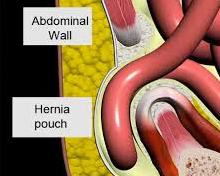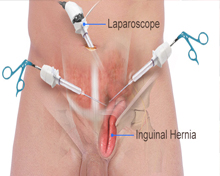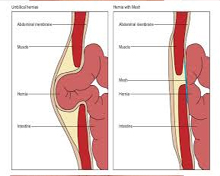Guide lines for Hernia patients
Guide lines for Hernia patients

Many diseases develop in to worst condition because patient is not conscious about the main facts of illness. Persons must know common guidelines of hernia disease to prevent harmful consequences. Basically, a hernia is an opening or weakness in the muscular structure of the wall of the abdomen.
This defect causes a bulging of the abdominal wall. This bulging is usually more visible when the abdominal muscles are tightened, thereby increasing the pressure in the abdomen. Hernias occur where there is habitual weakness in a membrane which holds and organ in anatomically. When the membrane becomes weak then the organ contained within it begins to protrude out. Initially, the opening is small and generally the protruding organ can be put back.
The most common position for hernias is the groin (or inguinal) area. There are several reasons for this tendency. First, there is a natural anatomical weakness in the groin region which results from partial muscle coverage. Second, the upright position of human posture results in a greater force occurring at the bottom of the abdomen thereby increases the stress on these weaker tissues.
There are many types of hernias. Umbilical hernia is one which protrudes through the umbilical area at the navel, ordinarily called belly button. This is the only hernia which repairs itself. It may be present at birth in babies but normally heals it self in the first few months after birth.
In inguinal hernia, abdominal contents stick out the inguinal canal. It can be on either side of the body. These form about 80 % of all hernias. Generally men are more affected with this type hernia than is women. Another classification of hernia is femoral hernia in which there is a protrusion of a loop of the intestine through a weakening in the abdominal wall. The weakening in the abdominal wall is generally located in the groin near the thigh. These are more common in women than in men.
Other hernias based on anatomical categorization include inguinal, and femoral hernias. Epigastric hernia is one in which abdominal contents protrude in the midline of the abdomen between the breast bone and the umbilicus (navel). Hiatus Hernia occurs at the opening of the diaphragm into the oesophagus where it attaches to the stomach. In some patients the muscle around the opening becomes weak or is congenitally weak. Hence the uppermost part of the patient's stomach may protrude through the diaphragm into the thoracic cavity. This type of hernias does not cause any symptoms. The patient does not observe a bulge on the outside.
If the patient becomes symptomatic then he might complain of heartburn, indigestion, and chest discomfort. Hiatal hernias are most frequently managed with medication and diet changes. Surgery may be needed in some cases.
When a hernia can be smoothly guided back into the cavity where it belongs then is said to be reducible. In the early stages the opening in the membrane is usually small and when the patient sits or lies down the hernia may become reduced obviously and the patient does not feel any distress. Irreducible hernias occur when the protruding organ cannot be guided back into the cavity where it belongs. When strangulation occurs then the blood supply to the protruding part, generally intestines, is impaired or completely cut off.
A strangulated hernia is a medical surgical emergency. If the blood supply is completely cut off the gangrenous and ensuing sepsis may be fatal to the patient. Incisional Hernias may be reducible or irreducible. Incisional are the end product of poor healing of a previous operation.
The first sign of an Incisional hernia is redness around the
surgical site soon after the operation. When this occurs, it is
important to inform the doctor so that the patient may be
followed up frequently. Hernia patient exhibits symptoms like
pain or discomfort and a localized swelling somewhere on the
surface of the abdomen or in the groin area.

Exams and Tests: If Patients have an obvious hernia, the doctor may not require any other tests. If patients show symptoms of a hernia such as dull ache in groin or other body area with lifting or straining but without an obvious lump then the doctor may feel the area while increasing abdominal pressure. This action may make the hernia able to be felt. If Patients suffer from an inguinal hernia, the doctor will feel for the potential pathway and look for a hernia by inverting the skin of the scrotum with his or her finger.
Causes of Hernias: Hernias do not develop abruptly. There are environmental and physical stress factors involved in developing hernia. They usually take a long time to develop. Opposing of common knowledge hernia is common in babies, toddlers and teens. The fundamental cause is generally some inborn weakness. In these situations even minor straining can result in a hernia. Common of hernia are gross and Morbid Obesity commonly cause hernias, mild Obesity can also cause a hernia, lifting heavy weights can cause hernias, straining which is related to constipation can produce this condition, persistent strong coughing and/or sneezing are known to cause hernias. Some women develop hernias during pregnancy.
Prevention As a rule there are no specific things you can do to prevent a hernia. Changing life style may be helpful. People have to maintain the correct weight according to age, sex, body type and activity. They must eat a healthy diet and generally keep fit by exercising regularly. They can refer to dietitian for dietary plan, visit doctor or a Registered Nurse if required. People have to prevent constipation by exercising and eating diet rich in fibers. It is advised for hernia patients that they must not lift heavy weight. In case of emergency, they can use leg muscles rather than waist or abdominal muscles. If person is ill, he must immediately visit a doctor so that allergies and cough can be controlled. Smoking must be avoided because it increases the risk of developing a hernia.
Treatment Most patients go for surgical repair of hernias. If patients are not fit for surgery they can contain the organ and prevent the hernia from getting worse. The simple advice is that the patients have to visit doctor as soon as possible. If a hernia becomes worse then the consequences could be deadly. Generally, a registered doctor would recommend herniorrhaphy. In medical terms, it means, "repairing the hernia". There are two types of herniorraphy.
The first one is conventional surgery. This involves an abdominal incision under general anaesthesia. During this procedure the protruding tissues are either removed (excised) or pushed back into the abdomen. Finally, the abdominal wall is repaired and strengthened. Some surgeons use a taflon graft to do this. Other surgeons sew the abdominal wall. This results in strengthened by bringing the surrounding muscles over it and in closer proximity. Another type of hernia repair is laparoscopic surgery.
In this procedure, general anesthesia is given to patient before
surgery. The surgeon uses a long metal viewing tube inserted
through a tiny incision. The rest of the procedure is much the
same as in conventional surgery. In this type of surgery the
patient is allowed to go home sooner and he can to return to
work quicker.

Risks factor with Repairing of a Hernia In today's modern surgical interventions, risk is reduced in surgical procedure. However, some degrees of risks continue. But some risk is involved as it is a surgery. One of the risks is dysuria. After this procedure, many patients experience difficulty passing urine.
This may occur if there is bladder sphincter spasm. Testicular swelling may occur in male patients because of the proximity of the abdominal organs. Wound infection may occur due to primary or secondary sources of infection. Primary, secondary or reactionary bleeding may also occur if proper post operative care is not given to patients. Scar is formed after healing of wound. If the patient had laparoscopic surgery then a hernia may develop in the area through which the instrument was passed. Postoperative chest infections and other complications like DVT, PE and non-healing of wound may occur.
After successful surgery, most patients can start to eat and drink normally upon discharge from hospital. Post operatively, in most hospitals, nurses will generally guide the patient on when to resume eating. Nausea and vomiting are common postoperatively and the nurse will, if prescribed, give the patient an antiematic.
Pain management is an essential part of post operative care and the Registered Nurse will give patients pain controlling medications as necessary. If there are no complications and the patient had open excision surgery, he may have to stay in hospital until the sutures are removed. If the surgery was knothole and there were no other complications, then he may be discharged home the same or next day. Follow up appointment is generally to check and observe that surgery is successful.
Note: This information is just for knowledge of disease. If such type of medical condition develops, consult your doctor.
Articles on Health
- Laparoscopic Surgery Advantages
- Laparoscopic Surgery History
- Laparoscopic surgery Procedures
- Limitations of traditional laparoscopic surgery
- New technologies for advance laparoscopic surgery
- Non-Robotic Laparoscopic Surgery
- Robotic Laparoscopic Surgery
- Causes and remedy for dark circles in females

- Harmful impact of mobile phone on unborn baby

- Maternal health care tips

- Rheumatoid Arthritis is Most Widespread in Female
- Periodontal ailment during Pregnancy
- Anemia is prevalent in Women
- Effect of Cell phone tower radiation on human health

- Current health scenario india
- Government health policies india
- Medical facilities india
- Hospital infrastructure india
- Shortage of Medical Professionals in India
- Quality standards indian hospitals
- Indian states health statistics
- Medical expenses india
- Hospitals in Ahmedabad
- Hospitals in Bangalore
- Hospitals in Chennai
- Hospitals in Cochin
- Hospitals in Delhi
- Hospitals in Hyderabad
- Hospitals in Kolkata
- Hospitals in Mumbai
- Hospitals in Pune
- Hospitals in Coimbatore
- Hospitals in Kochi
- Orthopaedics Hospitals in India
- Diabetology Hospitals in India
- Cardiology Hospitals in India
- Infertility Hospitals in India
- Neurology Hospitals in India
- Paediatrics Hospitals in India
- Nephrology Hospitals in India
- Oncology Hospitals in India
- Antiaging foods to improve skin

- Tips for Maintaining healthy bones
- Guidelines for preventing heart disease
- Tips to reduce eye strain while working on computer
- Mental health problems among elderly people
- Health problem of piles

- Health advices for air travel

- Dealing with Allergies
- Tips for Eyes Care
- Care for Crystal Clear Skin
- Tips For Healthy Hair
- Healthy Living is The Absolute Measure of Happiness
- Let Fragrance Rule Your Summer
- Most common vestibular disorder

- Osteoporosis Risk Factors
- Dengue

- Endocrine disorder

- Causes of liver damage
- Dry eye syndrome
- Kidney Stones
- Conjunctivitis: Irritating eye disease
- Anxiety Disorder
- Causes of Brain Damage
- Hepititis B
- Knowledge of Osteoarthritis
- Mental Illness
- Back Pain
- Sugar Addiction
- Diet Control Plans
- General Motors Diet Plan
- No Carbohydrate Diet
- One day Diet Plans
- Seven day diet Plans
- Vegetarian Diet
- Food for Health
- Genetically Modified Foods
- Healing Effects Of Fruits
- Vegetables That Heal
- Healing Effects Of Spices and Herbs
- Test your Stress Level
- Mantras for Relaxation & Stress free life
- Take walk For a healthy body and mind
- Squint is frequently observed in Children
- Consult-Doctor
- Free Handy Health Advice